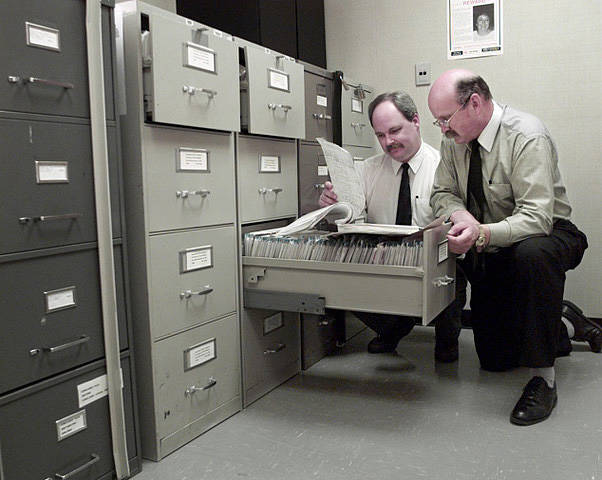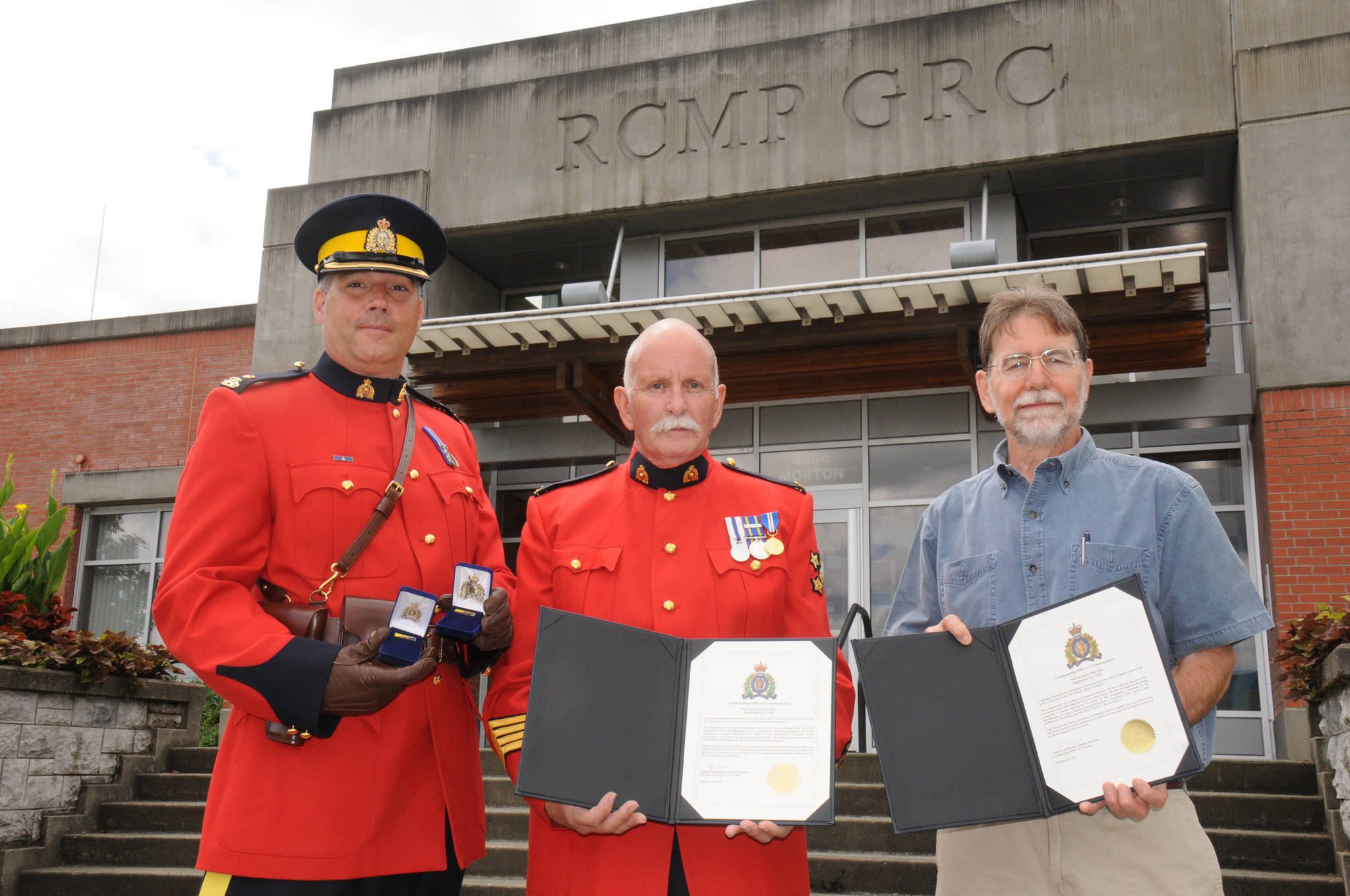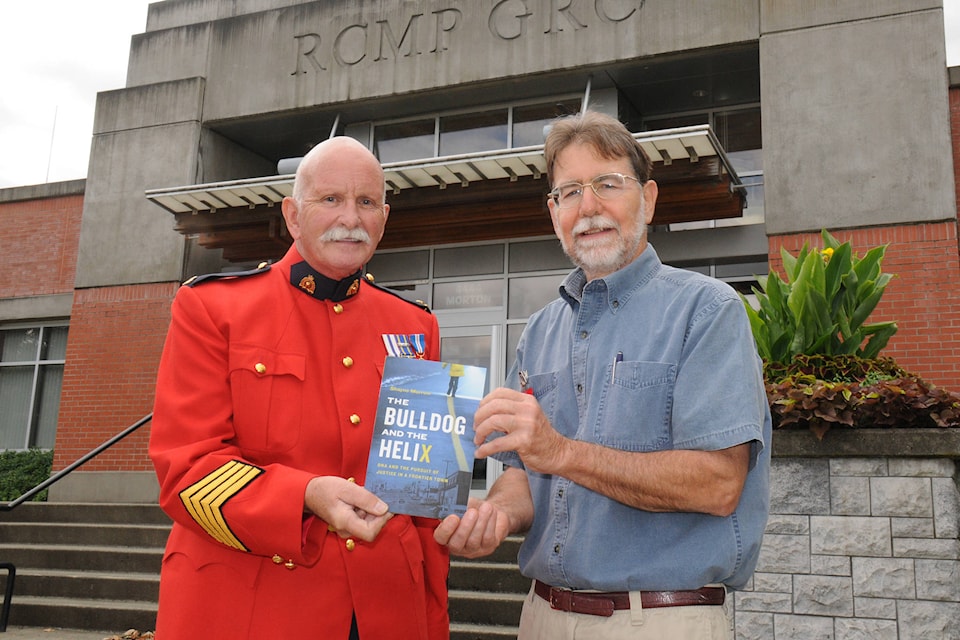Retired RCMP Staff Sgt. Dale Djos put the final stamp on his policing career last Wednesday when he received a pair of Commanding Officer’s Commendations for solving two cold case murders.
Port Alberni RCMP Inspector Eric Rochette presented Djos, who retired from the RCMP in 1999, with the awards on July 21, 2021 in a small ceremony at the Morton Street detachment.
“It’s a nice sendoff. It was totally unexpected. It really puts a final touch on both cases. I’m quite honoured that they’ve gone to that extent. Even if it is a number of years later I find it very heartwarming,” said Djos, standing outside the detachment in his red serge.
Djos was one of three members, including retired Cpl. Dan Smith and forensic scientist Hiron Poon, to receive the commendations. They helped solve the 1977 murder of 12-year-old Carolyn Lee and the 1996 murder of 11-year-old Jessica States using DNA technology, which was cutting edge at the time.
READ: High-profile Port Alberni murders are the centre of new true crime book
Djos and Smith were lead investigators on both the Lee and States murders—which took place 20 years apart in Port Alberni and involved different perpetrators. Hiron Poon was the forensic scientist working at the RCMP’s DNA Analysis Unit in Vancouver who was responsible for identifying Roddie Patten as the prime suspect in the States murder.
Retired Port Alberni journalist Shayne Morrow detailed the police investigation of both murders in his 2019 book, The Bulldog and the Helix: DNA and the Pursuit of Justice in a Frontier Town.
Djos said retired RCMP Inspector Ian Parsons of Comox started the ball rolling after reading Morrow’s book after it was published in 2019. He contacted E Division headquarters suggesting Djos, Smith and Poon deserved commendations. The request was finally approved at the national level, and arrangements were made to present Commanding Officers Commendations to all three.
Smith did not have a ceremony due to COVID-19 restrictions: he picked his up a month ago at his local Campbell River RCMP detachment. Djos said Poon was going to receive his at a formal meeting.
Djos recalled how DNA helped them solve both cases. In the States murder, they collected blood samples from hundreds of people.
“Especially with Jessica’s case that was unbelievable that we got the match, because we forwarded so many (DNA) samples over. They’d always come back negative,” he said—until the one that came back positive.
“I guess in my mind I knew we attacked the case the right way by taking blood samples from so many people, and the cooperation of the community was outstanding. This is one of the first cases where a large sample like that had ever been considered or taken, strictly with the consent of the person providing…a blood stain the size of a quarter, basically. We took it from there. No one objected. We felt unless you had something to hide, why wouldn’t you come forward?
“If you think of the family and the age of this girl and what happened to her…it was a real plus when we got the match.”
Smith said it was nice to be recognized for the years of work he put into both investigations. “I felt honoured to be assigned these important files in the first place,” said Smith, who retired from the RCMP in 2008 but now works part time as a court liaison officer at the Campbell River detachment.
“To see them come to a resolution was very heartwarming. To ultimately be recognized by the force for the work that was done was very rewarding.”
Smith said other cases have been solved by DNA technology, but these two cases were key: Port Alberni’s RCMP investigators were able to use DNA techniques in subsequent investigations due to what they learned with the Lee and States cases.
Solving both cases was a defining moment in Smith’s policing career. He still remembers the moment in 1996 that he learned a suspect had been identified in the States murder.
“I was actually camping here in the Campbell River area,” he said from his home in the North Island community. “They sent the park rangers to get me.
“I had just got there and I thought they were coming to collect my fee, and I explained I’d already paid.”
When the rangers told him they were sent to get him to make an important call back at the office, “I didn’t even pack up my stuff; I rolled it into a big ball and threw it in the car and screamed back to work. I cancelled my holidays.”
Besides that first call, Smith said getting a confession out of Patten was another key moment.
“Over time, you develop techniques. In this particular case it paid off. You don’t often get a confession to a first-degree murder.”
While the Lee murder file was already 11 years old when he received it, and he never met any of the family members, the States case was difficult because he spent time with Jessica’s parents. “I felt so bad that something so terrible would happen to their family and them. It was tough.
“Especially in the early stages of an investigation you can’t promise anything…they never lost faith in us.”
Smith said while he was proud to have received the commendations, he was part of a large team of RCMP members who helped solve both murders—particularly the general investigation section (GIS) in the Jessica States case.
“It’s hard to understand just how much is involved (in an investigation),” he said.
“They all should be commended. Everyone involved did huge amounts of work and very good policing standards.”
susie.quinn@albernivalleynews.com
Like us on Facebook and follow us on Twitter





